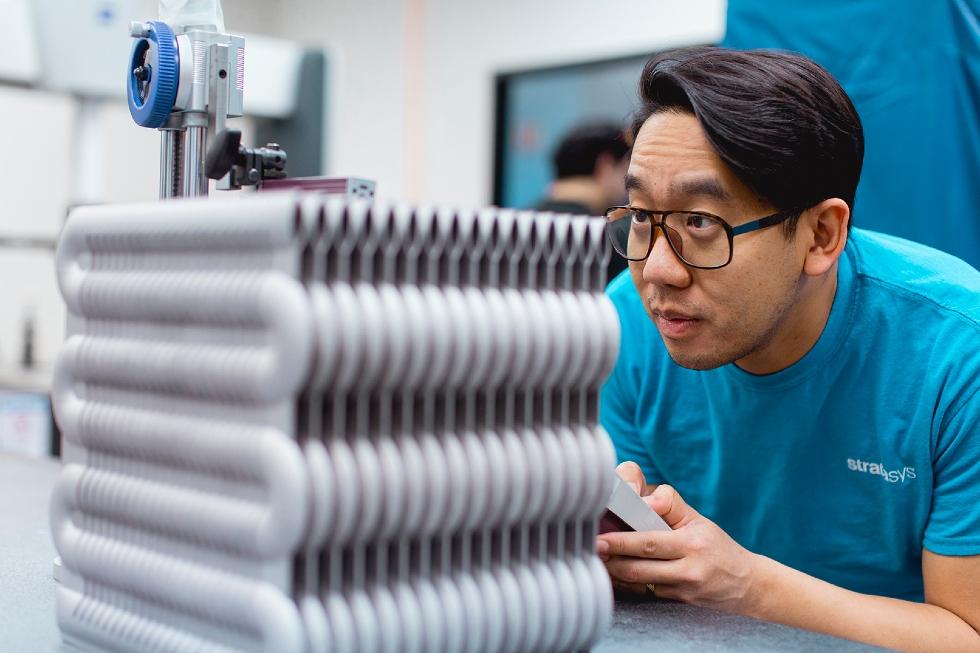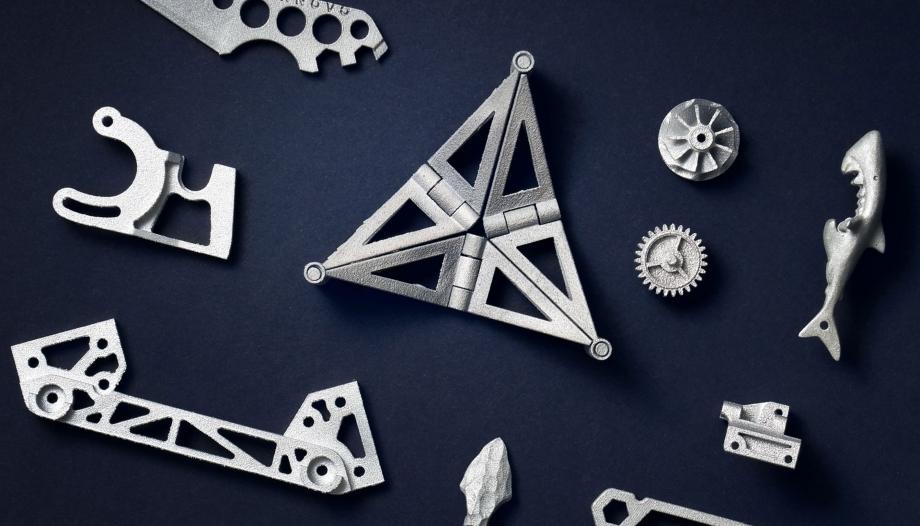- FMA
- The Fabricator
- FABTECH
- Canadian Metalworking
Our Publications
Categories
- Additive Manufacturing
- Aluminum Welding
- Arc Welding
- Assembly and Joining
- Automation and Robotics
- Bending and Forming
- Consumables
- Cutting and Weld Prep
- Electric Vehicles
- En Español
- Finishing
- Hydroforming
- Laser Cutting
- Laser Welding
- Machining
- Manufacturing Software
- Materials Handling
- Metals/Materials
- Oxyfuel Cutting
- Plasma Cutting
- Power Tools
- Punching and Other Holemaking
- Roll Forming
- Safety
- Sawing
- Shearing
- Shop Management
- Testing and Measuring
- Tube and Pipe Fabrication
- Tube and Pipe Production
- Waterjet Cutting
Industry Directory
Webcasts
Podcasts
FAB 40
Advertise
Subscribe
Account Login
Search
On-demand manufacturers give customers a wide range of 3D printing options
Many online service bureaus offer everything from 3D printing to machining—and a lot in between
- By Kip Hanson
- May 20, 2020
- Article
- Additive Manufacturing

Ordering a part from an online service bureau can be as simple as uploading a CAD file, entering your credit card information, and waiting for delivery of your 3D-printed part. Getty Images
I spent my first dozen or so years in the workforce as a machinist in a mom-and-pop shop. The owner or his son quoted each job. People used fax machines to place sales and purchase orders. Customers were OK with delivery times of weeks—or even months.
And even though our shop had a row of Bridgeport knee mills and another of Hardinge chuckers—the early ’80s version of rapid prototyping machines—ordering one piece of practically anything was inordinately expensive.
That’s all changed. Anyone who can upload family photos to their Shutterfly account can just as easily upload a CAD file to any of several dozen web-based manufacturing sites. You simply enter your credit card information and in a few days take delivery of a 3D-printed, injection-molded, fabricated, or machined version of said file.
There are no endless lead times, no premium for a one-off, no haggling with the shop’s owner over piece price or a part’s manufacturability. Everything is just … easy.
The takeaway? Although the small job shops like the one that I worked at are still around, I suspect their days are numbered.
Enter the ‘Storefront’
Or are they?
Greg Paulsen, director of application engineering at Xometry Inc., Gaithersburg, Md., suggested his company’s business model is actually beneficial to these shops because it provides their owners and staff more time to focus on what they do best: make stuff.
“Of the thousands upon thousands of parts we ship each day, most are made by one of our partners, which is usually a small job shop,” he said. “Our job is to be the storefront, helping customers with design questions as well as material and manufacturing process selection, then sourcing that work to qualified shops. It’s a win-win for all concerned.”
As you might have guessed, Xometry is an online provider of manufactured parts. As with all such providers, its customers first set up an account, then select whatever processes and materials they think will work best for their parts, and, usually within a minute or two, receive an automated quote that they can either accept or reject.

Aside from AM, many service bureaus provide traditional manufacturing services, such as machining, plastic injection molding, and sheet metal fabrication. Xometry
If they accept, they enter their credit card information, sit back, and wait for the FedEx truck to arrive. Depending on the process, part quantity, and whether the part is manufacturable, the wait is typically a few days to a week.
Manufacturability is a key component of the process, and it helps explain the success of these increasingly popular services. Although Xometry and virtually all other providers employ sophisticated, almost artificial intelligence-like quoting engines, these companies also employ real people who are available to answer questions, provide design guidance, and suggest alternatives when needed.
And if the wheels come off the AI bus because of poor product design—it happens—these same humans then can pick up the virtual pieces, call the customer, and point them in the right direction.
Beyond the Bureau
An interesting aspect of these on-demand services is that because they are usually either quite large or built upon a network of smaller shops, they can offer a far broader selection of manufacturing processes than any mom-and-pop shop ever could. The service bureaus of the past were limited to whatever their in-house 3D printers could produce, whereas many of today’s online service bureaus offer a complete lineup of additive manufacturing technologies.
These include metal and polymer-based SLS, FFF, MJF, DLS, SLA, PolyJet … the list goes on. This variety of technologies opens the door for designers and entrepreneurs who want to test various additive waters without having to visit multiple providers.
There’s much more to this than 3D printing, however. Aside from the smorgasbord of additive technologies, Xometry and others like it offer a range of more traditional manufacturing services too, including machining, injection molding, and urethane casting.
One of these is Los Angeles-based Stratasys Direct Manufacturing. Lewis Simms, the company’s solutions marketing and communications manager, noted that online service bureaus have expanded well beyond 3D-printed prototypes and low-volume parts.
“We do everything from one-offs to full serialized production, with tens of thousands of units going out the door each month,” he said. “For instance, one of our facilities has manufactured more than 30,000 aircraft details and assemblies.” Others are producing patterns for investment castings, jigs and fixtures, forming tools, and a variety of end-use components, he added. “We even work with people who have their own manufacturing facilities but want the opportunity to evaluate technologies they don’t currently have, or help them out with overflow support.”
Here again, ordering a single part or even a truckload of parts can be done with as much human intervention as the customer desires, provided the design is manufacturable. If not, Stratasys Direct and most other service providers have extensive design and manufacturing information available on their websites, helping even the newbie designer get up to speed quickly.

Ordering parts can be done with as much—or as little—human intervention as the customer desires. Stratasys
Rejection Prevention
Matt Boyle, vice president of architecture at Shapeways Inc., tells a similar story, but one focused exclusively on 3D printing. With locations in New York and The Netherlands, Shapeways began with a business-to-consumer model, he explained, but has started shifting at least some of its focus over the past two years to serving more industrial customers.
“This was done to address the growing industrialization of additive manufacturing,” Boyle said. “We still have the consumer at heart, but we're also making sure that we can address these (industrial) markets as well. And as we get into that space, our offerings have increased, with new capabilities in metal AM, for example, and binder jetting.”
As a result of all the industrialization, Boyle noted one interesting development: Users generally are getting better at designing printable parts and leveraging AM’s remarkable capabilities, yet the community still has miles to go before achieving design nirvana. Until that heightened state is reached, the AI and advanced software tools that Shapeways and its competitors employ will continue to fill the gaps—literally—in uploaded part models.
“We have a couple of tools in our toolkit that can do model repair and mesh healing, automated functions that fix common problems such as inverted vertices, for instance, or a gap in a mesh,” he said.
He added that having a “leakproof model” doesn’t guarantee that the part will be printable. All kinds of factors can cause a build to fail, like walls that are too thin, internal features that can’t be supported, and printing fine details.
“It’s simple enough to reject these files, but we feel it’s far better to work with customers as needed to get them a usable part, and if it turns out to be something that we can’t do, we’ll suggest an alternative design or even a different manufacturing process,” Boyle said. “That said, these situations are becoming less common as our capabilities increase and as additive grows ever more capable.”
About the Author

Kip Hanson
About the Publication
- Podcasting
- Podcast:
- The Fabricator Podcast
- Published:
- 04/16/2024
- Running Time:
- 63:29
In this episode of The Fabricator Podcast, Caleb Chamberlain, co-founder and CEO of OSH Cut, discusses his company’s...
- Trending Articles
- Industry Events
16th Annual Safety Conference
- April 30 - May 1, 2024
- Elgin,
Pipe and Tube Conference
- May 21 - 22, 2024
- Omaha, NE
World-Class Roll Forming Workshop
- June 5 - 6, 2024
- Louisville, KY
Advanced Laser Application Workshop
- June 25 - 27, 2024
- Novi, MI



























